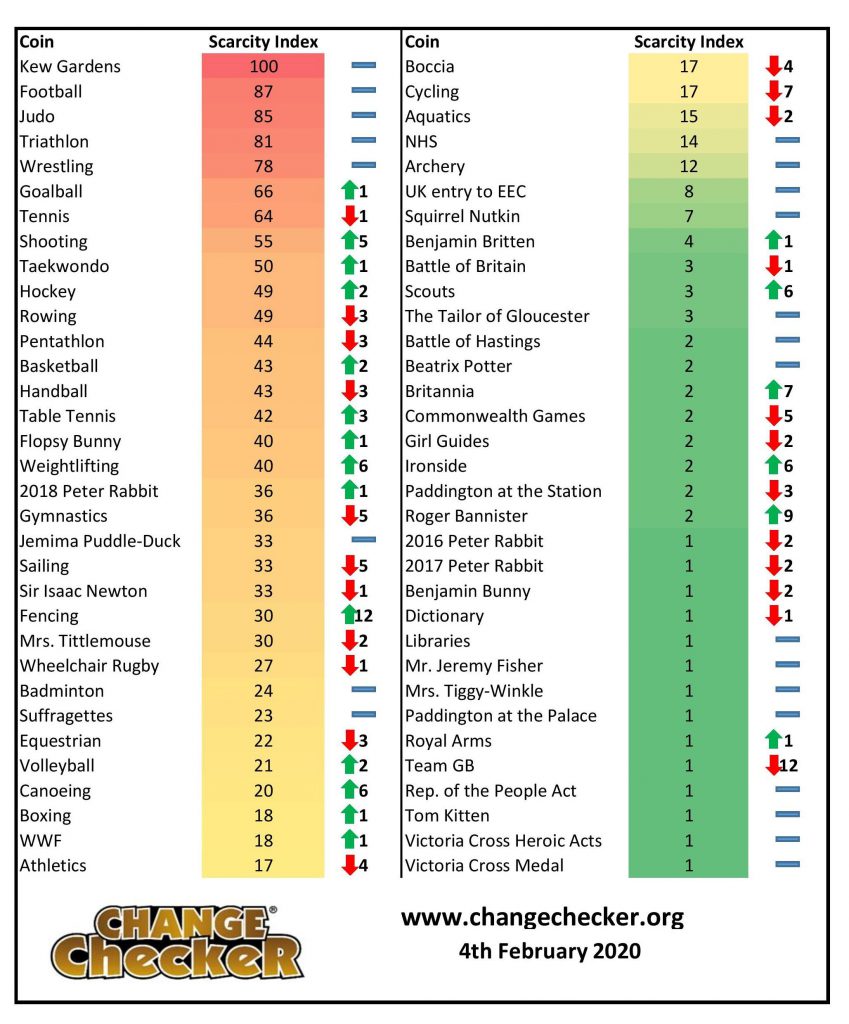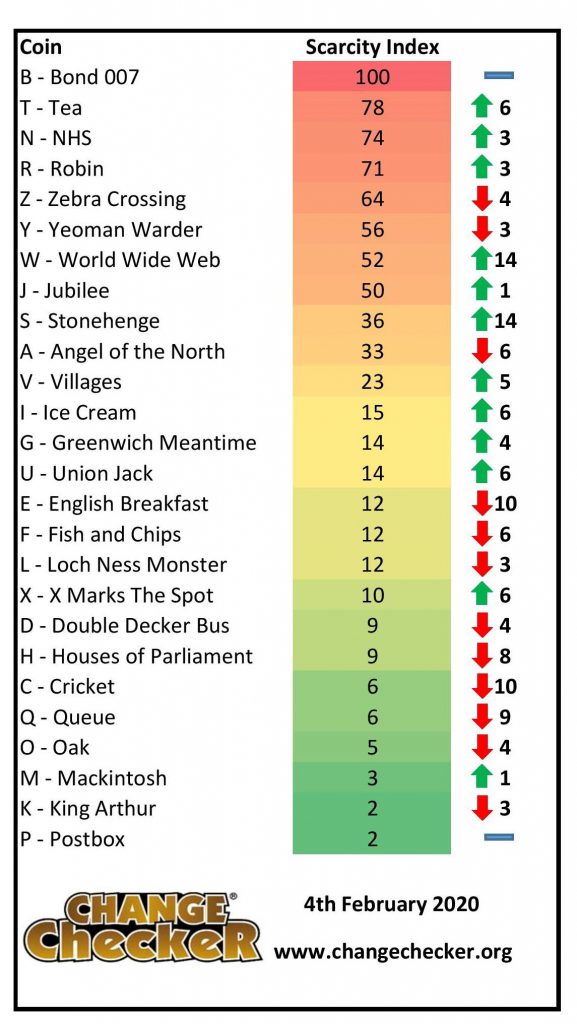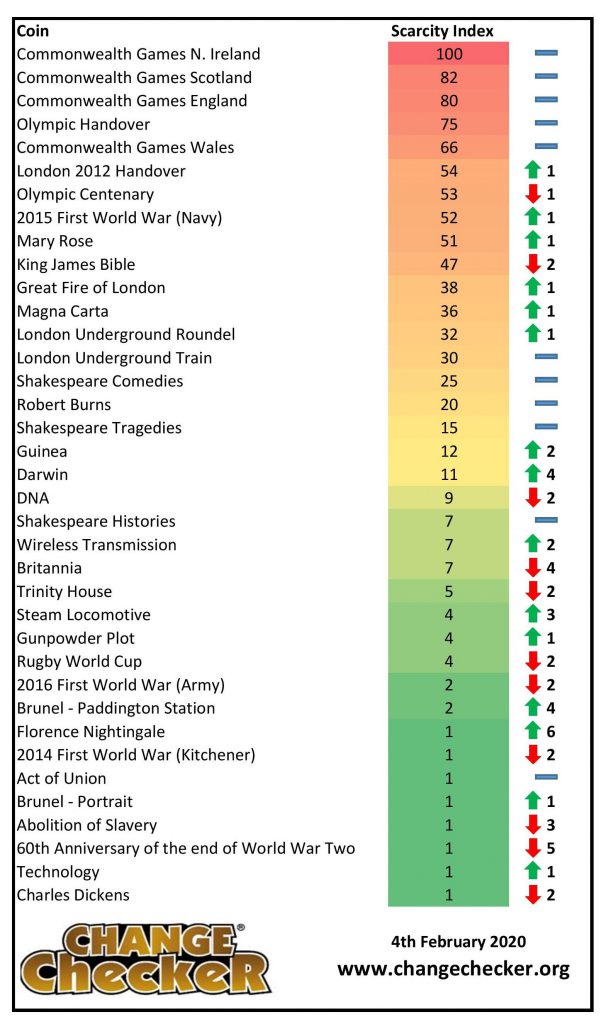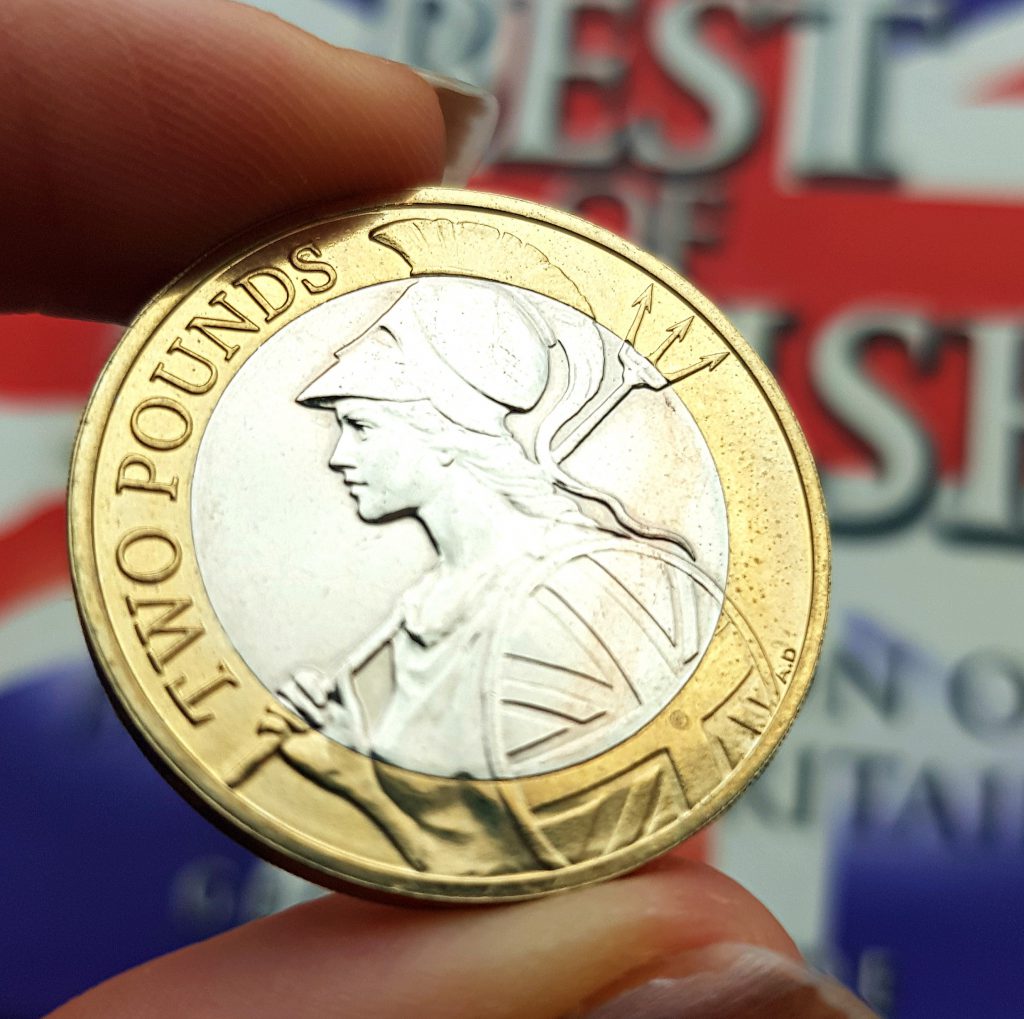Posts Tagged ‘Coins’
2020 Scarcity Index Update!
We’re excited to reveal to you the very first Scarcity Index of 2020!
The updated 50p, A-Z 10p and £2 indexes below allow you to discover how sought-after the coins in your collection really are…
This information has been compiled using data from the Change Checker Swap Centre and presented in the easy to use indexes below, with arrows to signify how many places up or down a coin has moved since the last Scarcity Index.
50p Scarcity Index

The previous Scarcity Index update saw some exciting changes to the 50p index, as we were able to include the 2018 50p coins following the release of their mintage figures.
This was great news for Change Checkers who have the 2018 Beatrix Potter 50ps in their collection, as both the Flopsy Bunny and Peter Rabbit 50ps have proved incredibly sought-after.
Despite both coins having the same mintage figure of 1,400,000, the Flopsy Bunny 50p is the most sought-after of the Beatrix Potter coins and is in fact the scarcest non-Olympic 50p coin in circulation, aside from of course the Kew Gardens 50p – the UK’s most sought-after circulation 50p.
Whilst both the Flopsy Bunny and 2018 Peter Rabbit 50ps have moved up the index one place since the last update, the other 2018 50ps haven’t fared quite so well, with the Mrs Tittlemouse and Paddington at the Station both moving down the index and the other 2018 50ps remaining unchanged.
The biggest mover on this latest Scarcity Index update goes to the Olympic Fencing 50p, which has moved up the index an incredible twelve places, following its five place drop on the previous update.
As we look forward to the Olympic Games which will be held in Tokyo later this year, perhaps we’ll see more of the Olympic 50ps increase in popularity by the next Scarcity Index update.
A-Z 10p Scarcity Index

We’re used to seeing quite a bit of movement on the A-Z 10p index as these particularly tricky-to-find coins are snapped up by collectors.
Interestingly, in this latest update only the top and bottom coins have remained unchanged, with B for Bond staying on top spot as the current scarcest A-Z 10p coin in circulation.
For many, this coin seems to be a firm favourite from the A-Z of Great Britain collection which was released in 2018, so it comes as no surprise that it has found its way to the top of the list.
P for Postbox is unfortunately bottom of the pile once again, although it’s worth remembering that all of these coins are considered sought-after and collectors fortunate enough to come across just one will be considering themselves lucky.
The biggest movers on the latest 10p index update are W for World Wide Web and S for Stonehenge, which have both moved up the index by 14 places.
S for Stonehenge actually dropped by 14 places in the previous index, so this could be the coin levelling back out again.
It will be interesting to see how the index changes as more collectors come across these coins and as we await the release of the 2019 mintage figures. We currently know that 220,000 of each design entered circulation in 2018 and a further 2.1 million coins overall were released in 2019, but exact figures for individual 2019 designs are currently unknown.
£2 Scarcity Index

Following the 2018 mintage figure reveal, we know that no £2 coins have entered circulation since 2016, so the £2 index continues to remain fairly stable with no new coins to add to the mix.
The top five coins are unchanged since the last index and it comes as no surprise that the Commonwealth Games Northern Ireland £2 remains on the top spot, as this £2 has a mintage figure of just 485,500 and is considered incredibly sought-after amongst collectors.
All three Olympic themed £2 coins (Olympic Handover, Olympic Centenary and London 2012 Handover) also remain very close to the top of the index and I wonder if the Tokyo Olympics this year will affect the scarcity of these already very popular coins.
The biggest mover on the £2 index is the Florence Nightingale coin, which has moved up by six places, whilst the 60th Anniversary of World War Two coin has moved down by five places to the third from bottom space.
As I’m sure you’ll agree, it would be fantastic to see some new £2 coins entering circulation and how they might affect the £2 Scarcity Index. Fingers crossed they’ll be enough demand for these coins to enter circulation soon!
How your Scarcity Index works
Generally collectors have had to rely upon mintage figures to identify the scarcest coins. But they only tell part of the story. Trying to find a good quality coin from 15 – 20 years ago, even for a higher mintage issue, is much more challenging than a more recent issue, as coins become damaged over time and are ultimately removed from circulation.
Additionally, some designs are more hoarded than others by people who might not normally collect coins – the poignant First World War £2 Coin series being an example. Finally, it can be up to a couple of years before the Royal Mint eventually confirms the actual mintage for an issue.
That’s why we have combined the mintage information with two other key pieces of information.
- How many of each design are listed as “collected” by Change Checkers, indicating the relative ease of finding a particular coin.
- The number of times a design has been requested as a swap over the previous 3 months, showing the current level of collector demand.
Importantly, as new coins are released and popularity rises and falls across different designs the Scarcity Index will be updated quarterly allowing Change Checkers to track the relative performance of the UK’s circulation coins.
How much are my coins worth?
The Scarcity Index does not necessarily equate to value but it is certainly an effective indicator. For example, the Kew Gardens 50p coin commands a premium of up to 200 times face value on eBay.
You can use the 6 point guide to help you determine a more realistic value for your coins.
What about £1 Coins?
The £1 Scarcity Index has already been published for the Round £1 coins and, because they are no longer being issued, this is now set in stone.
If you’re interested in coin collecting, our Change Checker web app is completely free to use and allows users to:
– Find and identify the coins in their pocket
– Collect and track the coins they have
– Swap their spare coins with other Change Checkers

Sign up today at: www.changechecker.org/app
Official UK Brexit 50p released!
*** UPDATE ***
An extra 1.5 million Brexit 50ps have been released into circulation following the 3 million initially released when Britain left to EU.
The Treasury has confirmed the number of Brexit 50p coins will increase to 10 million by the end of the year to satisfy collector demand.
On the 31st January 2020 the United Kingdom left the European Union – over three and half years after the Vote.
This departure is possibly one of the most historically significant events to happen in modern history, so we know collectors will be extremely excited to hear a brand new United Kingdom coin has been issued to commemorate the occasion.
The 2020 UK Brexit 50p has been officially released today and is the only official United Kingdom coin to commemorate the occasion.

Although the design had been rumoured some time ago, the final design features the inscription ‘Peace, prosperity and friendship with all nations‘ and the all-important date – 31st January 2020 – underneath.
However, this brand new 50p isn’t the only coin to have been issued to documents Britain’s relationship with the European Union.
In this blog, we take a look back at the coins which tell the story of the 43 year long partnership between the UK and the EU.
1973 European Economic Community 50p
In 1973, after over a decade of debate and discussion, Britain was finally successful in joining the EU – then known as the European Economic Community (EEC).
To mark such a ground-breaking partnership, The Royal Mint issued the FIRST-EVER commemorative 50p!
It’s hard to believe there was a time when commemorative 50p coins weren’t commonplace, but this 1973 coin was the very first of its kind!
The design features nine hands clasping each other in a circle, symbolising the nine member state of the community.
As the first-ever commemorative 50p, it’s unsurprising this release is considered hugely significant in British history, numismatic history, and is a staple of any UK coin collection. You can secure one for your collection for JUST £5.00 by clicking here >>
The 1973 EEC 50p had a circulating mintage of 89,755,000.
1992/3 European Council Presidency 50p
In 1992/3 the UK celebrated its presidency of the European Council of Ministers, and the completion of the Single Market.

The intricate design of this 50p, by Mary Milner Dickens (who later designed the 2000 Libraries and the 2003 Suffragettes 50ps) shows a conference table seen from above, around which are the 12 chairs for the Council of Ministers.
However, what makes this 50p particularly special and sought-after by collectors is not the design, but the mintage.
This 1992/3 European Community Presidency 50p had a circulating mintage of JUST 109,000! It is the rarest UK 50p to EVER enter circulation.
When you consider the Kew Gardens is the rarest 50p currently in circulation and has a mintage of 210,000 you start to grasp how small the mintage for this 50p really is!
Any Change Checker who is lucky enough to have this coin in their collection must be incredibly pleased!
1998 UK Entry to the EEC 25th Anniversary 50p
In 1998 a new United Kingdom 50p was issued to commemorate 25 years since the UK joined the EEC.
Remarkably, this European-Union-inspired 50p coin is the subject of another numismatic first – the first ‘new sized’ commemorative 50p to be issued following the specification change in 1997.

The old larger coins were removed from circulation and it’s this new sized 50p that has featured some of our most iconic coin designs and has become the most collected coin in the world!
Designed by John Mills (designer of the much-loved 1994 D-Day 50p), the reverse of this coin shows 12 stars to represent the 12 ministers and had a circulating mintage of 5,043,000.
And there we have it! The UK’s relationship with the EU as told by coins!
It’s incredible to look back at some of the most ground-breaking 50p issues that are tied to this 47 year relationship.
Do you have any of these coins in your collection? Let us know in the comments below!
Brand new UK Brexit 50p – Secure yours today
As you would expect with a coin this historic the brand new UK Brexit 50p has been struck to superior Brilliant Uncirculated quality and protectively encapsulated in official Change Checker packaging to preserve its quality forever.
The Top 5 Coins of the Decade
I still can’t quite believe 2020 is here and we’re into a new decade! But what better excuse could there be to take a look back at some of our favourite coin releases from the past 10 years?
Along with new coins, the numismatic world as a whole seems to have expanded as a new generation of collectors have discovered the joy of this fantastic hobby.
There’s no denying we’ve seen some incredible coins released since 2010, but the Change Checker team have picked out our personal favourite TOP FIVE.
So without any further ado, here are the coins we believe to be the greatest of the past 10 years. Drum roll please...
1. The London Olympic and Paralympic 50ps

Issued to mark the 2012 Olympic and Paralympic Games hosted by London, this coin series played a huge part in transforming the 50p into the UK’s most collectable coin.
29 different 50p coin designs were released to commemorate the different sports and across the nation millions rose to the challenge of collecting them all.
The Royal Mint now estimates that as many as 75% of the Olympic 50p coins have been removed from circulation by collectors, which is a testament to their popularity.
It was certainly the Olympic 50p series that reawakened the nation’s love of coin collecting in the last decade, so we just had to include them at the top of our list!
2. The Beatrix Potter 50ps

Next up is a series which inspired a whole new generation of collectors, and for that reason it would be a crime not to include the Beatrix Potter 50p series on our list.
Just like me, I’m sure you’ll have fond childhood memories of reading the enchanting tales of Peter Rabbit and his friends as a child and this beautiful 50p series really does do justice to those memorable tales.
4 years, and 14 coins later, the Beatrix Potter 50p coins remain one of the public’s favourite ever collection of coins.
Since The Royal Mint released the first Beatrix Potter 50ps in 2016, these charming coins have created a collecting frenzy, becoming increasingly sought-after to this day.
I’m sure I’m not alone when I say that this is one of the stand-out coin series of all time, let alone the decade!
3. Queen Elizabeth II’s 90th Birthday £5

As a nation, we’ve celebrated Her Majesty the Queen’s landmark birthdays, jubilees and wedding anniversaries during her long and eventful reign.
Traditionally, the Queen’s birthday milestones are celebrated with £5 coins, as seen issued in both 1996 and 2006 to mark her 70th and 80th birthdays.
And so, this decade, when Queen Elizabeth II became the first British monarch to celebrate their 90th Birthday, the release of this £5 coin in 2016 was particularly special and hugely significant for collectors around the world.
This was the only official UK £5 coin to mark this special occasion, designed by acclaimed artist Christopher Hobbs, who captured the Queen’s love of flowers, showing nine roses – one for each decade of the Queen’s life.
4. 2015 Britannia £2

Britannia has a long standing history with British coinage, having featured on a British coin in one way or another for more than 300 years.
In 2008 she was surprisingly dropped from the 50p, despite a Daily Mail campaign to save her. However in February 2015 it was announced that Antony Dufort’s modern interpretation of Britannia would be making a triumphant return to British circulating coins, replacing the definitive £2 “Technology” design which had featured on the coin since 1997.
This was a very popular move from The Royal Mint, but it wasn’t until the mintage figures were announced that the real surprise was unveiled…
Only 650,000 of the 2015 dated Britannia £2 coins had been stuck for circulation, making it one of the rarest UK £2 coins ever!
The rarity and numismatic significance of this coin as the UK’s new definitive £2 means it had to earn a spot on our Top Five list.
5. The A-Z of Great Britain 10ps

In 2018, The Royal Mint sparked huge excitement across the nation with the surprise release of 26 brand new 10p coin designs.
Each coin design was created to represent an image of what makes Britain British from A – Angel of the North, all the way to Z – Zebra Crossing, and collectors quickly fell in love with these unique coins.
Figures for 2018 confirm that 220,000 of each design entered circulation, meaning each design is almost as rare as the Kew Gardens 50p – the UK’s rarest coin in circulation!
A further 2.1 million A-Z 10ps were released in 2019 overall, meaning there really aren’t many to go around and many collectors are struggling to come across them in their change as they are being snapped up so quickly.
The A-Z 10ps really have been one of the biggest numismatic talking points of the decade and so they just had to be included on our list. Have you been lucky enough to find any?
Of course there have been so many other incredible releases in the past 10 years and narrowing it down to just five was a tough job, but we certainly feel that these coins have got to be highlights of the last decade.
Let us know which coins would make it into your Top Five in the comments below!
If you’re interested in coin collecting, our Change Checker web app is completely free to use and allows users to:
– Find and identify the coins in their pocket
– Collect and track the coins they have
– Swap their spare coins with other Change Checkers

Sign up today at: www.changechecker.org/app






